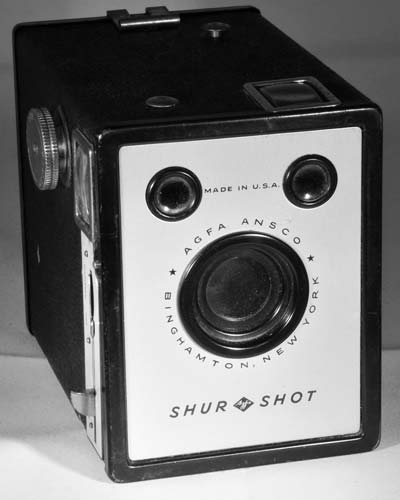Agfa Ansco Shur-Shot
Specification

| Manufacturer | : | Agfa-Ansco |
|---|---|---|
| Produced | : | 1932-1940 |
| Classification | : | Medium Format |
| Body Type | : | Box |
| Construction | : | Cardboard, Wood, Metal |
| Film Type | : | 120 |
| Film width | : | 62mm |
| Image Size | : | 2¼ x 3¼ in |
| No. of Images | : | 8 |
| Lens Type | : | Meniscus |
| Focus Type | : | Fixed |
| Focal Length | : | 95mm |
| Focus Range | : | 8ft to inf. |
| Aperture Type | : | Variable |
| Aperture | : | f/14,f/22 |
| Shutter Type | : | Rotary |
| Shutter Speeds | : | B,I*(1/40 sec) |
| Size (w x h x d) | : | 90 x 107 x 128 mm |
| Weight | : | 387g |
| * Measured on this camera | ||
Art Deco Credentials
![]()
Limited: Minor and insubstantial
- Produced during the main Art Deco period;
- Plain front plate;
- Chrome surrounds to viewfinders;
- Chrome rear door latch;
- Chrome handle rivets.
Description
The Agfa Ansco Shur Shot series began in 1932 and ended in 1940. Shur Shot cameras originally carried the name Agfa-Ansco in use at that time. Post-1941 models were branded as Ansco alone because of the German connection of Agfa. Although the Agfa Ansco Shur-Shot is a simple camera made from cardboard, wood and metal, it is particularly well made. It is capable of capturing eight 2 1/4 x 3 1/4 inch exposures on standard no. 120 roll film. This basic box construction hadn't changed much from when box cameras first appeared. The camera is made of a water resistant fiber body covered in black imitation leather, with a plain metal faceplate. The back is also made of metal. The shutter assembly is supported with a wooded block. There was a diagonal handle on the top.
The camera is fitted with a fixed focus lens for taking photos from about 8 feet to infinity. There are two apertures available but only one shutter speed. The glass single meniscus lens is located behind the shutter and aperture to obtain the optimal performance from a simple lens design. The shutter provides a snapshot speed of about 1/40 of a second. Film advance is by the use of a ruby window on the back door. This ruby window is only half the size you would expect on such a camera. It has a metal winding knob. The two brilliant viewfinders for landscape and portrait orientation give a nice preview of the image. They are much better than the earlier ground glass type found on early box cameras. There is no cable release socket and no tripod mount.
Bulb exposures are acheived by pulling a small tab outwards. This model also includes another tab which allowes for the positioning of either a smaller aperture (approximately f/22) or a yellow filter, in front of the main lens. (The filter was intended for black & white photography, e.g. to deepen the tone of blue skies.)
For maintenance, the metal faceplate of the camera can be taken off by lifting tabs away from two small pegs which gives access to the shutter and viewfinders. By carefully manipulating the shutter mechanism, access to the lens allows cleaning with cotton buds. As in many box cameras, highly polished steel plates were used for the interior reflective surfaces of the viewfinders instead of mirrors. These seem to stand the test of time better than mirrored glass surfaces.
How to Use
This camera takes 120 film which is easily available.
With modern film, it is advisable to cover the red window with black tape. Uncover the window to wind on, but only in low light conditions.
As the shutter speed is only 1/40s, it is advisable to use a tripod to get clear shake free images. However, holding it against a wall or other solid object would work as well. For quick snapshots, hold it firmly against your body.
If you don't want to bother with an exposure meter, follow the guide shown. It is based on the 'Sunny 16' rule. Film is so forgiving and will produce acceptable results even when overexposed by 2 or 3 stops or underexposed by 1 stop.
The tables assume that the sun is at least 30 degrees above the horizon - that's 10am - 5pm on a summers day (May - August) in the UK.
Remember that the exposure guide in the manual may not be helpful as it is based on the use of old film with a low ISO value.
Using ISO 100/125 film - shutter speed 1/40s
| Weather Conditions | Shadow Detail | Aperture | Exposure |
|---|---|---|---|
 Sunny SunnySnow/Sand | Dark with sharp edges | f/22 | +1 Stops Overexposed Acceptable |
 Sunny Sunny | Distinct | f/22 | Good |
 Slight Overcast Slight Overcast | Soft around edges | f/14 | Good |
 Overcast Overcast | Barely visible | f/14 | -1 Stop Underexposed Acceptable |
 Heavy Overcast Heavy Overcast | None | f/14 | -2 Stops Underexposed Not Acceptable |
 Open Shade Open Shade/Sunset | None | f/14 | -3 Stops Underexposed Not Acceptable |